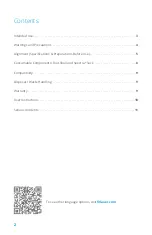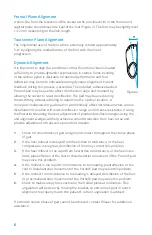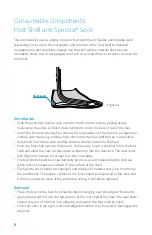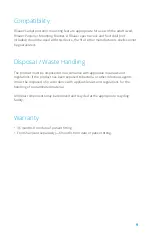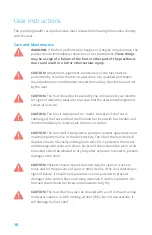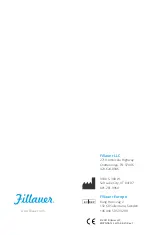
6
Frontal Plane Alignment
A plum line from the bisection of the socket at the proximal brim in the frontal and
sagittal plane should bisect the keel of the foot (Figure 2). The foot may be slightly inset
1–12 mm depending on the limb length.
Transverse Plane Alignment
The longitudinal axis of the foot will be externally rotated approximately
5–8° by aligning the medial border of the foot with the line of
progression .
Dynamic Alignment
It is important to align the prosthesis so that the anterior keel is loaded
sufficiently to provide dynamic response late in stance. Some bending
of the carbon pylon is desirable for optimal performance and foot
deflection may be more noticeable during dynamic alignment. Patient
feedback during this process is essential. The included, adhesive backed
Poron® pad may be used to affect dorsiflexion range and moment by
allowing the socket to resist dorsiflexion. The pad may be used during
the test fitting without adhering to determine the optimal location. A
more proximal/posterior pad location will minimally affect dorsiflexion while a more
distal/anterior location will resist dorsiflexion range and increase resistance. If using
the Posterior Mounting Bracket, adjustment of plantar/dorsiflexion angles using the
and alignment wedges will help achieve a smooth transition from heel to toe and
provide adjustment of transverse plane foot rotation.
1.
Check for smoothness of gait and ground contact throughout the stance phase
of gait.
2.
If the heel rollover is delayed from heel strike to midstance, or the heel
compression is too great, dorsiflexion of foot may correct this problem.
3.
If the heel rollover is too rapid from heel strike to midstance, or the heel is too
hard, plantarflexion of the foot or distal/anterior movement of the Poron® pad
may solve this problem .
4.
If the rollover is too rapid from midstance to toe loading, plantarflexion of the
foot or distal/anterior movement of the Poron® pad may solve this problem.
5.
If the rollover from midstance to toe loading is delayed, dorsiflexion of the foot
or proximal/posterior movement of the Poron® pad may solve this problem.
6.
Check to make sure pylon is vertical in the frontal plane at midstance. This
angulation will be done by moving the bracket, so extra time spent in bench
alignment to properly match the patient’s current angulation is advised .
If a smooth stance phase of gait cannot be achieved, contact Fillauer for additional
assistance .
5°
Figure 2
Содержание Aeris Activity
Страница 1: ...Aeris Activity Product Manual...


